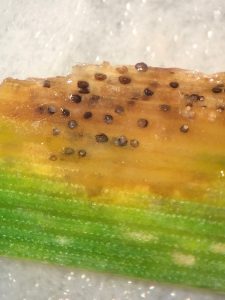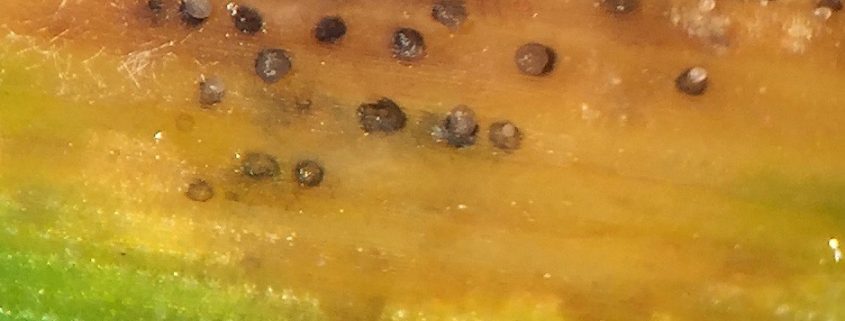Wisconsin Winter Wheat Disease Update – May 21, 2019
Damon Smith, Extension Field Crops Pathologist, Department of Plant Pathology, University of Wisconsin-Madison
Brian Mueller, Assistant Field Researcher, Department of Plant Pathology, University of Wisconsin-Madison

Figure 1. Septoria leaf blotch on wheat leaves
Winter wheat in Wisconsin continues to move through growth stages at a fairly even pace. Winter wheat plots in our research program located at the Arlington Agricultural Research Station, Arlington, Wisconsin are just approaching the emerging flag leaf stage. Perhaps by the weekend or early next week, flag leaves will have emerged. Interestingly, this growth stage will likely occur almost at the same date as in 2018. Last season, we applied our Feekes 8 fungicide treatments on May 25th. So while it has been cool, and wheat appears to be moving through growth stages slowly, things aren’t too far off from 2018.
Weather remains very wet. Most wheat we have scouted this week appears to be clean of disease. One concern we have is the development of Septoria leaf blotch. In 2016 we had an early epidemic of this leaf disease, that impacted yield. The cool conditions are not particularly conducive for this disease, but the high humidity and wet conditions certainly are. Weather forecasts indicate warmer conditions over the next week, thus keep your eyes peeled for the development of the disease.

Figure 2. Pycnidia in a Septoria leaf blotch lesion.
Septoria leaf blotch can be identified by necrotic lesions that develop on leaves of winter wheat (Figure 1). Small fruiting structures (pycnidia) can often be identified inside the necrotic area of the lesions, with the naked eye or a good hand lens (Figure 2). Prolonged wet/humid conditions broken by a brief dry period, followed by more wet conditions, can favor infection. Temperatures between 60 and 77 F favor disease development. Septoria leaf blotch can be managed with varietal resistance (both race-specific and partial resistance) and also fungicides. For a list of effective fungicides for Septoria leaf blotch control, CLICK HERE to download a copy of the Small Grains Fungicide Efficacy Table. For more information pertaining to Septoria leaf blotch, and other related leaf blotch diseases, CLICK HERE to download a fact sheet.
Reports from the the mid south and plains states continue to indicate stripe rust is on the move. Continue to monitor and scout wheat as your crop moves into the flag leaf stage and to heading. If stripe rust moves in, a fungicide application may be warranted. As I indicated in my previous update, we did not have a stripe rust epidemic in 2018, in Wisconsin. Thus, there was no inoculum in the state to infect fall-sown wheat. Inoculum for an epidemic to initiate in 2019 will have to come from the southern U.S. The best way to make an educated decision to spray is to scout and catch the disease in its early stages. Continue to pay attention to extension reports as we track stripe rust from the southern U.S., northward.





